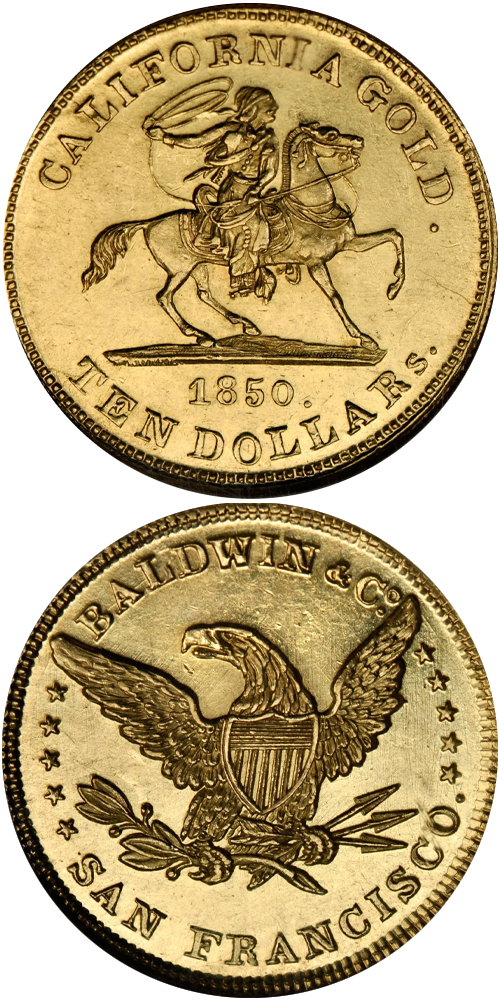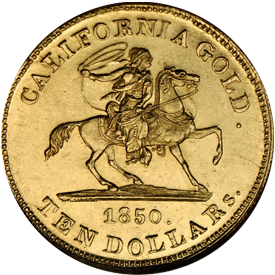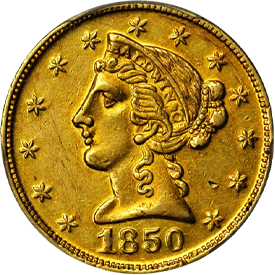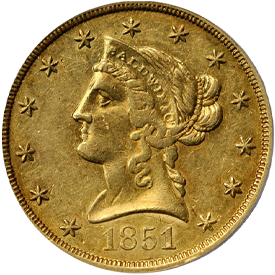Baldwin & Co., owned by George C. Baldwin and Thomas S. Holman, jewelers, was in business as early as April 1, 1850. During that month they acquired the coining apparatus and related equipment of F. D. Kohler & Co.
The coinage of Baldwin's was quite extensive and was second only to that of the United States Assay Office of Gold. In the period from January 1 to March 31, 1851, Baldwin's production outranked the Assay Office by $590,000 worth of coins as compared to the Assay Office efforts which totaled $530,000.
James King of William, a leading banker and public figure, submitted a number of Baldwin coins to Augustus Humbert for assaying. It was discovered that the pieces were below the stated face value, unconscionably so in the view of citizens at the time, who were accustomed to receiving nearly full metallic value. For example, the Baldwin $20 pieces averaged an intrinsic value of $19.40, the $10 pieces averaged $9.74 and the $5 pieces were valued at $4.91.
On April 9, 1851, the Pacific News ran the following commentary:
"THE GOLD COIN SWINDLE. It is perhaps a matter of no especial wonder that the community feels outraged because of the fact that nearly all of the gold coin put in circulation by the private manufacturing establishments is short of weight. A citizen last evening went to Baldwin's establishment, and, presenting two of their own Twenty Dollar gold pieces, asked their redemption in silver. These were taken, and thirty-eight dollars returned.
This is about as cool and direct a piece of shaving as has come under our eye, touching the short-weight gold coin swindle. Why should the community suffer this to go on longer? Why not refuse every dollar of Baldwin's coin? as well as that of every other that is not of full value and redeemed on demand. A bank-bill is worth no more than the bare paper upon which its pretty picture is printed, except from the fact that securities are pledged for its redemption. So also with Baldwin's coin. It is worth no more than the actual value of the gold when compared with the Government standard.
In the instance we refer to, there was a loss of five percent, and as Baldwin's establishment has an immense deal of coin in circulation the proprietors must make a very neat little speculation out of the country and ultimately amass wealth at the expense of the honest and industrious citizens. The only way to stop this swindle seems to be to refuse the coin altogether, not only that issued from Baldwin's mint, but from every other that proves a short weight and not to be redeemed on presentation.
Public indignation was aroused and from this point onward the Baldwin coins were rejected by merchants. Later they changed hands, but only at a 20 percent discount from their face value — a figure significantly less than their metallic worth. It is believed that the firm ceased coining after Humbert's findings were publicized. The end of the enterprise was chronicled by the Pacific News on April 17, 1851:
We hear a story, which is pretty well authenticated, that Messrs. Baldwin & Bagley, the manufacturers of "Baldwin's Coin," left in the steamer Panama on Tuesday for the Atlantic states. This is of course what might have been anticipated as the finale of so magnificent a financial operation as the coinage of one or two millions of circulating medium upon which they have pocketed a profit from 1 0 to 15 percent, less the expense of manufacturing the stuff. Unable longer to impose their false tokens upon the community, an outraged public will now pocket the loss and congratulate themselves that the swindle has been exposed even this early.
The amount of this coin in circulation is not less than $1,000,000, and is probably nearer to two. But suppose that the smaller sum be correct, the profit to the manufacturers is one hundred thousand dollars. Whose swindling false token establishment is next to be chronicled amongst the "Departures for Panama?"
In addition to Humbert's assay, a $10 piece of 1850 evaluated at the Philadelphia Mint was found to have an intrinsic value of $9.96. A group of 100 $20 pieces of 1851 , assayed at the same institution, was found to have an average value of $ 19.33.
In 1850 Baldwin made $5 and $10 pieces, the $10 featuring a vaquero, or mounted horseman. In 1851 $10 and $20 denominations were produced. The dies were cut by Albert Kuner.
As the Baldwin pieces were not highly prized at the time, most of them were melted. During their period of coinage, the earlier part of the Gold Rush era, there was virtually no collector interest in them. Indeed, numismatics in America was still in its infancy. The survival of Baldwin & Co. pieces was strictly a matter of chance. Today all Baldwin issues are of extreme rarity.









